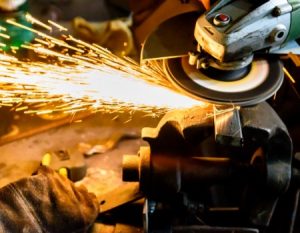
Guy Fawkes Night – that one day of the year when we all enjoy watching the night sky light up and sizzle in memory of an event that narrowly avoided seeing the Houses of Parliament go up in flames!
While not wanting to spoil anyone’s fun later this evening, fire prevention and safety is a serious concern at this time of the year. Meanwhile, for the construction industry, this is a concern that affects sites across the country every day.
The latest available data shows that, during 2017, there were 408 fires on construction sites in England (that’s more than one for every day of the year). But, with good management, tight control over day-to-day site procedures and a commitment to reducing hazards, most fires in construction can be avoided.
The biggest fire risks come from ignition and fuel hazards (combustible materials) but both of these are things you can control. Here are some of the big issues to look out for:
Ignition Risks
- Electrical faults – Most sites have a combination of fixed electrical wiring from mains sources and electricity generated from fixed or mobile power generators. Faults cause fires so all electrical installations must be tested, inspected and commissioned before they are first used and re-inspected at appropriate intervals. Electrical equipment should undergo Portable Appliance Testing (PAT) in accordance with the HSE guidance note HSG107.

 Hot working – Hot works are defined as ‘processes involving the generation of heat by a naked flame, electrical arc, sparks, and the use of bitumen boilers or grinding’. Welding, cutting, brazing and the use of blow lamps or soldering equipment are all examples. For these type of operations, risk assessments must be carried out and all workers must all be suitable trained, not only in the safe use of any equipment but also in fire risk and prevention measures. Ideally hot works should be carried out in restricted areas and only commence once formal checks have confirmed that a safe method of work is in place. It’s important also to ensure hot works areas are monitored during breaks and that a cooling down/ ‘fire watch’ period is applied at the end of such activities.
Hot working – Hot works are defined as ‘processes involving the generation of heat by a naked flame, electrical arc, sparks, and the use of bitumen boilers or grinding’. Welding, cutting, brazing and the use of blow lamps or soldering equipment are all examples. For these type of operations, risk assessments must be carried out and all workers must all be suitable trained, not only in the safe use of any equipment but also in fire risk and prevention measures. Ideally hot works should be carried out in restricted areas and only commence once formal checks have confirmed that a safe method of work is in place. It’s important also to ensure hot works areas are monitored during breaks and that a cooling down/ ‘fire watch’ period is applied at the end of such activities.
(On our sites, we always issue a Hot Work Permit to the Main Contractor Site manager, stating the timing of the works, the specific work location and who is the appointed person for supervision.)
- Lighting and lamps – It can sometimes be necessary to illuminate particular areas of work on a construction site using temporary lighting or lamps. What makes these items hazardous usually comes down to their location (e.g. being too close to combustible materials). Because they have high operating temperatures, halogen and halide lights should be avoided. Lamp holders should be provided to ensure bulbs of different operating voltages cannot be interchanged and those not fitted with a bulb should be capped off. Like all other equipment, lighting units should undergo periodic inspections to ensure there are no faults.
- Arson – Arson attacks (where someone deliberately starts a fire) on construction sites are unfortunately on the rise. During 2017, 42% of all construction site fires (170 fires in total) were started deliberately. To prevent this kind of incident, site access should be strictly controlled; security measures should be in place at all times; flammable/ combustible materials must be safely stored or removed from site when not in use; and waste management procedures should exist to avoid any build-up of combustible materials (which represent an easy opportunity for the arsonist).
Fuel Hazards
- Flammable gases and liquids – Fuel (including flammable gases and liquid fuel) may be required on site for hot cutting and plant machinery. The site manager must take responsibility for the management of fuel, including close monitoring of everything from procuring the correct fuel in the first place to ensuring it’s used correctly and overseeing potentially hazardous operations such as refuelling.
- Combustible building components – Controlling combustible materials is critical to site safety and materials should not exceed the quantities required for a day’s work. Storage of fuel packages should be limited, a gap of 6-10m should be left between them and care should be taken to ensure there are no readily ignitable substances nearby. For instance, a stack of wood is instantly easier to ignite if it’s kept in flammable packaging or stored nearby a pile of waste. With multi-storey timber frame buildings, there have been some serious fire incidents during the construction phase which have led to the rapid collapse of unprotected frames. Specific guidance to reduce this risk can be found from the Structural Timber Association.

 Waste materials – Whether it’s packaging, scrap, contaminants or oily deposits, waste materials are a fire hazard. The site should have a Waste Management Plan which highlights the correct procedures for minimising and disposing of all waste materials effectively. Plastic containers should be especially avoided and look out also for things like cleaning rags which, if used to mop up oils or grease, must be disposed of immediately.
Waste materials – Whether it’s packaging, scrap, contaminants or oily deposits, waste materials are a fire hazard. The site should have a Waste Management Plan which highlights the correct procedures for minimising and disposing of all waste materials effectively. Plastic containers should be especially avoided and look out also for things like cleaning rags which, if used to mop up oils or grease, must be disposed of immediately.
- Fire retardant scaffold and temporary covering materials – To avoid adding to the fire risks on site, there are several materials that must only be used if they are marked as fire retardant. These include: timber scaffold boards (BS EN13501-1:2018 – Euroclass B or C); temporary coverings (tested to LPS 1215); and protective coverings for floors and walls (tested to LPS 1207). While complying with the relevant standards reduces risks, these materials are still combustible so it’s important not to over store them and to carry out any preparation tasks like cutting to size in a remote location.
Prepare for emergencies
Watching out for and controlling the hazards mentioned above are just some of the components of a full fire safety and prevention plan for construction sites.
The other side of the coin is to ensure that, should an emergency situation arise, your site has adequate arrangements in place to deal with it. To determine if your emergency ready, some key questions to ask include:
- Are emergency routes and exists sufficient for the size and layout of the site?
- Are routes/ exits well-signed and illuminated?
- Are routes/exist kept clear and unobstructed?
- Has sufficient fire-fighting equipment been put in place (where that is deemed necessary) and are workers trained to use them?
- Do you have enough trained fire marshalls and first aiders in your team? (At Sheriff all our site foreman are fire marshalls and trained to prevent unwanted accidents.)
Sheriff says…
While most construction sites are controlled every day by the magnitude of health and safety legislation, when it comes to fire safety there is no room for over-confidence. The consequences of fire are not worth taking any risks so preventing them from starting in the first place is absolutely vital. Although managers must take more responsibility in terms of carrying out the formal checks required, fire safety measures like the ones we’ve mentioned here must be everybody’s business.
Let’s all do our bit to keep our construction sites safe.
05.11.2019
Image source: Freepik








